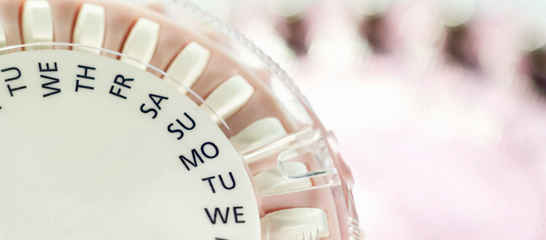




Common Health Problems » Women’s Health
The charts below give information on birth control methods. Discuss one(s) best suited for your needs with your doctor or health care provider. Ask for advice on more options. More than one birth control method may be needed to prevent getting pregnant and reduce the risk for sexually transmitted infections (STIs).
Signs of Pregnancy
-
•Missed menstrual periods. {Note: Stress or illness can cause a period to be late, too. And, some females do not have regular periods. It may be hard for them to know if their period is 2 weeks late. Other females can have a light menstrual period or spotting and still be pregnant. So watch for other signs also listed here.}
-
•Abnormal vaginal bleeding.
-
•Breast tenderness, swelling, and/or tingling.
-
•The dark areas around the nipples are darker than before and the tiny glands around the nipples stick up.
-
•Feeling tired.
-
•Nausea or vomiting.
-
•Frequent urination.
-
•Unusual food cravings or your taste for certain foods changes; a metallic taste in the mouth.
-
•Mood swings.
-
•Slight elevation in body temperature.
-
•Acne due to extra-active oil glands.

Resources




Method
Failure Rate*
Comments



Abstinence. No sexual intercourse between a female and a male.
0%
Has no medical or hormonal side effects.


HIV/STI Protection
Yes
Birth Control Patch. Hormones released from a skin patch worn on the skin weekly for 3 weeks; not worn the 4th week.
1%
Needs to be prescribed. Not a good method for females over 198 pounds. Increases the risk for blood clots and other serious problems.

No
Birth Control Pill. Hormones in pill form. Many types.
3%
Needs to be prescribed. Some medicines lessen the effects of the pill. Risk for blood clots, heart disease, and stroke, especially in women over 35 who smoke.

No
Cervical Cap. Plastic cap placed over the opening of cervix. Used with a spermicide.
16% if never gave birth; 32% if gave birth
Needs to be prescribed. Inserted before intercourse. Should be left in place for at least 6, but no more than 48 hours after last intercourse. Using this method can cause abnormal Pap tests.

No
Condom (Female). Polyurethane barrier placed inside the vagina.
21%
Can get over-the-counter. Should not be used at same time with a male condom. Can take time and patience to use the right way.

Yes
Condom (Male). Latex or polyurethane sheath worn over an erect penis.
11%
Can get over-the-counter. Slight risk of breakage. Loses quality when exposed to ultraviolet light, heat, and oil-based lubricants and creams.

Yes
Depo-Provera. Hormone given through a shot every 3 months.
Less than 1%
Needs to be prescribed. May cause irregular periods, weight gain, fatigue, and headaches. Once stopped, it can take 4 to 18 months for a woman to be fertile again. Can cause bone loss if taken for more than 2 years.

No
Diaphragm. Reusable, thin, soft, rubber cap that covers the cervix. Used with a spermicide.
6–16%
Needs to be prescribed. Should be checked for leaks. Size may need to be changed with weight changes. May dislodge during intercourse. Should be left in place at least 6, but no more than 24 hours after last intercourse.

No
Emergency Contraception Pills. High-dose birth control pills that need to be started within 72 hours after unprotected intercourse. Called “Plan B.”
11–25% – the sooner used, the more effective.
Can get over-the-counter. Needs to be prescribed for women age 17 and younger. The pills are taken in 2 doses, 12 hours apart. Can cause nausea, vomiting, breast tenderness, infertility, and blood clots.

No
Emergency IUD Insertion. Needs to be done within 7 days of unprotected intercourse.
Less than 1%
Needs to be done by a health care professional.

No
FemCap. Silicone rubber device. Fits snugly over the cervix.
14% if never gave birth; 29% if gave birth
Needs a prescription. Should be left in place for at least 6, but no more than 48 hours after last intercourse.

No
Implanon®. Thin plastic implant about the size of a match stick. Releases a low dose of the hormone progestin for up to 3 years.
Less than 1%
Needs to be inserted and removed by a health care professional. Can cause irregular menstrual bleeding, mostly fewer and lighter periods or no periods.

No
Intrauterine Device (IUD). ParaGard. Small copper device inserted into uterus. {Note: An IUD does not prevent an ectopic pregnancy. With this, an embryo starts to grow outside the uterus. Most often, this is in a fallopian tube.}
Less than 1%
Needs to be inserted and removed by health care professional. Can be left in place for up to 12 years. May become dislodged. Risk of infection and piercing of the uterus. Need to learn how to check for the 2 strings that hang from the bottom of the IUD to make sure it is in the right position.

No
Intrauterine System (IUS). Mirena®. T-shaped device placed in uterus. Releases low dose of hormones every day for 5 years.
Less than 1%
Needs to be inserted and removed by a health care professional. May lessen menstrual cramps. Needs to be replaced every 5 years.

No
Lea’s Shield. Silicone cup with an air valve and a loop (aids in removal) that fits snugly over the cervix. Used with a spermicide.
15%
Needs to be prescribed. Should be left in place at least 8 hours after last intercourse, but no more than 48 hours total.

No
Natural Family Planning. Ovulation signs need to be checked for and kept track of.
20%
Sexual intercourse must be limited to “safe” days. Takes training, time, and record keeping to work right. Method for planning a pregnancy, too.

No
NuvaRing®. A soft, flexible ring that a female inserts deep into the vagina. Contains hormones.
1–5%
Needs to be prescribed. A new Ring is inserted once and kept in place for 3 weeks. It is removed the week of menstrual period. May cause increased risk for vaginal problems.

No
Spermicides (Foams, Jellies, Creams, Suppositories). Chemicals inserted into the vagina kill sperm before it enters the uterus.
15–21%
Can get over-the-counter. More reliable when used with condoms, diaphragms, etc. Inserted between 5 and 90 minutes before intercourse. Need to reapply for repeated acts of intercourse.

No
Sponge. Today® Sponge polyurethene foam barrier that contains spermicide. It is moistened with water and inserted into the vagina. It does not have hormones.
9–19%
Can get over-the-counter. Works for full 24 hours for repeated acts of intercourse. Must be left in place for 6 hours after last intercourse. Should not be worn for more than 24 hours after sex.

Some
Sterilization (Female). One type is a Tubal Ligation (having tubes tied). This surgery burns, cuts, or ties off the fallopian tubes. Another type, tubal implants (Essure®), is not surgery. A device is inserted through the vagina and uterus into each fallopian tube. This causes scar tissue to grow and plug the tubes.
Less than 1%
Permanent form of birth control. Should be used only when no more children are desired. Surgery usually needs general anesthesia. Sterilization implants do not.

No
Sterilization (Male). Vasectomy. Cuts the tubes through which sperm travels from the testes.
Less than 1%
Permanent form of birth control. Done as outpatient with local anesthesia. Not effective right away. Sperm can still be present for 20 ejaculations.

No
Withdrawal. The penis is removed before ejaculation.
Up to 27%
Have to control ejaculation. Sperm can leak before this occurs.

No
* Failure rate is the number of pregnancies expected per 100 females per year. If no method is used, the chance of pregnancy is between 85 and 90%.


2012 © All Rights Reserved - American Institute for Preventive Medicine | Disclaimer | Phone: 800.345.2476 | www.HealthyLife.com


